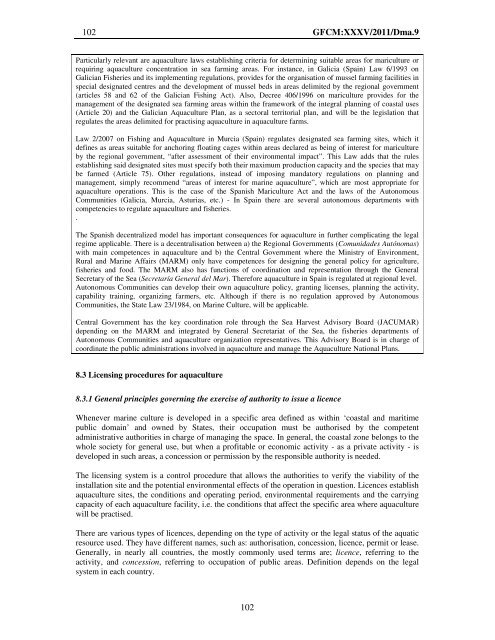Site selection and carrying capacity in Mediterranean ... - FAO Sipam
Site selection and carrying capacity in Mediterranean ... - FAO Sipam
Site selection and carrying capacity in Mediterranean ... - FAO Sipam
You also want an ePaper? Increase the reach of your titles
YUMPU automatically turns print PDFs into web optimized ePapers that Google loves.
102 GFCM:XXXV/2011/Dma.9<br />
Particularly relevant are aquaculture laws establish<strong>in</strong>g criteria for determ<strong>in</strong><strong>in</strong>g suitable areas for mariculture or<br />
requir<strong>in</strong>g aquaculture concentration <strong>in</strong> sea farm<strong>in</strong>g areas. For <strong>in</strong>stance, <strong>in</strong> Galicia (Spa<strong>in</strong>) Law 6/1993 on<br />
Galician Fisheries <strong>and</strong> its implement<strong>in</strong>g regulations, provides for the organisation of mussel farm<strong>in</strong>g facilities <strong>in</strong><br />
special designated centres <strong>and</strong> the development of mussel beds <strong>in</strong> areas delimited by the regional government<br />
(articles 58 <strong>and</strong> 62 of the Galician Fish<strong>in</strong>g Act). Also, Decree 406/1996 on mariculture provides for the<br />
management of the designated sea farm<strong>in</strong>g areas with<strong>in</strong> the framework of the <strong>in</strong>tegral plann<strong>in</strong>g of coastal uses<br />
(Article 20) <strong>and</strong> the Galician Aquaculture Plan, as a sectoral territorial plan, <strong>and</strong> will be the legislation that<br />
regulates the areas delimited for practis<strong>in</strong>g aquaculture <strong>in</strong> aquaculture farms.<br />
Law 2/2007 on Fish<strong>in</strong>g <strong>and</strong> Aquaculture <strong>in</strong> Murcia (Spa<strong>in</strong>) regulates designated sea farm<strong>in</strong>g sites, which it<br />
def<strong>in</strong>es as areas suitable for anchor<strong>in</strong>g float<strong>in</strong>g cages with<strong>in</strong> areas declared as be<strong>in</strong>g of <strong>in</strong>terest for mariculture<br />
by the regional government, “after assessment of their environmental impact”. This Law adds that the rules<br />
establish<strong>in</strong>g said designated sites must specify both their maximum production <strong>capacity</strong> <strong>and</strong> the species that may<br />
be farmed (Article 75). Other regulations, <strong>in</strong>stead of impos<strong>in</strong>g m<strong>and</strong>atory regulations on plann<strong>in</strong>g <strong>and</strong><br />
management, simply recommend “areas of <strong>in</strong>terest for mar<strong>in</strong>e aquaculture”, which are most appropriate for<br />
aquaculture operations. This is the case of the Spanish Mariculture Act <strong>and</strong> the laws of the Autonomous<br />
Communities (Galicia, Murcia, Asturias, etc.) - In Spa<strong>in</strong> there are several autonomous departments with<br />
competencies to regulate aquaculture <strong>and</strong> fisheries.<br />
.<br />
The Spanish decentralized model has important consequences for aquaculture <strong>in</strong> further complicat<strong>in</strong>g the legal<br />
regime applicable. There is a decentralisation between a) the Regional Governments (Comunidades Autónomas)<br />
with ma<strong>in</strong> competences <strong>in</strong> aquaculture <strong>and</strong> b) the Central Government where the M<strong>in</strong>istry of Environment,<br />
Rural <strong>and</strong> Mar<strong>in</strong>e Affairs (MARM) only have competences for design<strong>in</strong>g the general policy for agriculture,<br />
fisheries <strong>and</strong> food. The MARM also has functions of coord<strong>in</strong>ation <strong>and</strong> representation through the General<br />
Secretary of the Sea (Secretaría General del Mar). Therefore aquaculture <strong>in</strong> Spa<strong>in</strong> is regulated at regional level.<br />
Autonomous Communities can develop their own aquaculture policy, grant<strong>in</strong>g licenses, plann<strong>in</strong>g the activity,<br />
capability tra<strong>in</strong><strong>in</strong>g, organiz<strong>in</strong>g farmers, etc. Although if there is no regulation approved by Autonomous<br />
Communities, the State Law 23/1984, on Mar<strong>in</strong>e Culture, will be applicable.<br />
Central Government has the key coord<strong>in</strong>ation role through the Sea Harvest Advisory Board (JACUMAR)<br />
depend<strong>in</strong>g on the MARM <strong>and</strong> <strong>in</strong>tegrated by General Secretariat of the Sea, the fisheries departments of<br />
Autonomous Communities <strong>and</strong> aquaculture organization representatives. This Advisory Board is <strong>in</strong> charge of<br />
coord<strong>in</strong>ate the public adm<strong>in</strong>istrations <strong>in</strong>volved <strong>in</strong> aquaculture <strong>and</strong> manage the Aquaculture National Plans.<br />
8.3 Licens<strong>in</strong>g procedures for aquaculture<br />
8.3.1 General pr<strong>in</strong>ciples govern<strong>in</strong>g the exercise of authority to issue a licence<br />
Whenever mar<strong>in</strong>e culture is developed <strong>in</strong> a specific area def<strong>in</strong>ed as with<strong>in</strong> ‘coastal <strong>and</strong> maritime<br />
public doma<strong>in</strong>’ <strong>and</strong> owned by States, their occupation must be authorised by the competent<br />
adm<strong>in</strong>istrative authorities <strong>in</strong> charge of manag<strong>in</strong>g the space. In general, the coastal zone belongs to the<br />
whole society for general use, but when a profitable or economic activity - as a private activity - is<br />
developed <strong>in</strong> such areas, a concession or permission by the responsible authority is needed.<br />
The licens<strong>in</strong>g system is a control procedure that allows the authorities to verify the viability of the<br />
<strong>in</strong>stallation site <strong>and</strong> the potential environmental effects of the operation <strong>in</strong> question. Licences establish<br />
aquaculture sites, the conditions <strong>and</strong> operat<strong>in</strong>g period, environmental requirements <strong>and</strong> the <strong>carry<strong>in</strong>g</strong><br />
<strong>capacity</strong> of each aquaculture facility, i.e. the conditions that affect the specific area where aquaculture<br />
will be practised.<br />
There are various types of licences, depend<strong>in</strong>g on the type of activity or the legal status of the aquatic<br />
resource used. They have different names, such as: authorisation, concession, licence, permit or lease.<br />
Generally, <strong>in</strong> nearly all countries, the mostly commonly used terms are; licence, referr<strong>in</strong>g to the<br />
activity, <strong>and</strong> concession, referr<strong>in</strong>g to occupation of public areas. Def<strong>in</strong>ition depends on the legal<br />
system <strong>in</strong> each country.<br />
102
















